A guest post by Jed Cawthorn
With recent news that the US Army is considering changes to its JLTV requirement before authorising full-rate production, the UK’s decision to buy the same vehicle for our MRV-P requirement has been put on hold. In particular, the JLTV is less good than the Humvee it is intended to replace when launching TOW missiles. There are other concerns that have not been made public. As far as the UK was concerned, there were already worries about the price of JLTV. Originally, a figure of US$ 430,000 per vehicle was quoted by the UK MoD when it announced the decision to acquire the Oshkosh JLTV via an FMS contract. However, according to sources within DE&S, the un-integrated price has risen to US$ 700,000. If JLTV is going to be considerably more expensive than anticipated, there may be a case to reconsider a UK-made vehicle instead.
MRV-P Introduction
The Multi-Role Vehicle – Protected (MRV-P) is the UK Army requirement for a lightly armoured (or protected) utility vehicle to replace the Panther Command & Liaison vehicle, Husky Tactical Support Vehicle (Light), and Vector (Protected Pinzgauer) – all were purchased via UOR processes. MRV-P could also replace un-armoured LandRovers in some command and liaison roles and has the potential to replace the Foxhound LPPV in the future.
The requirement is split into groups or packagers; the Package 1 requirement is for the command & liaison and utility roles, Package 2 for an ambulance and troop transport, and Package 3 is for a light recovery vehicle able to rescue all of the above. A superb history and overview of the program is available here: https://www.thinkdefence.co.uk/multi-role-vehicle-protected/
The intention was to fulfill the requirement by competition, but the rumour mill has the Oshkosh L-ATV (JLTV) taking Phase 1, Thales Bushmaster Phase 2, and a variant of the Supacat HMT 600 platform taking fulfilling the light recovery requirements.
The case for a “Buy British” approach
Some months ago (autumn 2018) @ThinkDefence on Twitter suggested that a “Buy British” approach capitalising on a platform already in widespread use by the British Army, made sense e.g. Supacat HMT400 and HMT 600, known respectively as the Jackal Medium-Weapons Mount Installation Kit (M-WMIK) and the Coyote Tactical Support Vehicle (TSV). Supacat has recently designed a new armoured cab for the Lightweight Recovery vehicle, and it appears that the Army is going to convert existing Coyote platforms to this new configuration to meet the requirement. Secondly, the UK also acquired the Foxhound Light Protected Patrol Vehicle (LPPV). Developed in competition with the Supacat’s SPV400, it won the competition with production fast tracked by the UOR process. After the drawdown from Afghanistan Foxhound was taken into the core equipment fleet and some 400 now remain in service.
The Supacat HMT platform
The UK purchased around 400 Jackals in two variants, and took more than 200 Jackal Mk2A into the core equipment fleet after Afghanistan. These now equip light armoured reconnaissance regiments. Some 165 Coyote TSVs were purchased, and all were taken into the core fleet.
The argument is that if we have hundreds of these vehicles in service already, and the number will be added to with Light Recovery variants (or conversions) then why not utilise the platform, its chassis, suspension, engine and drivetrain to gain greater utility from a British design, and bring operational and budgetary benefits through widespread commonality? The new recovery variant provides a new design of cab, and that is another reason to extrapolate designs based on this platform.
Another military tweeter, @TotherChris did some great work converting Supacat’s line drawings of their vehicles to show how the HMT400 and 600 platforms, using a CAD program to keep the dimensions correct, all to show how they could be adapted to meet all MRV-P requirements, and beyond. Building on Chris’ impressive work, I have explored how the HMT400 and HMT600 series of vehicles might be able to fulfill the full range of roles. If we intend to keep the Jackal 2A in service in the light cavalry role, this would provide obvious benefits in commonality across the MRV-P fleet, with potential savings in training, maintenance and procurement of spare parts.
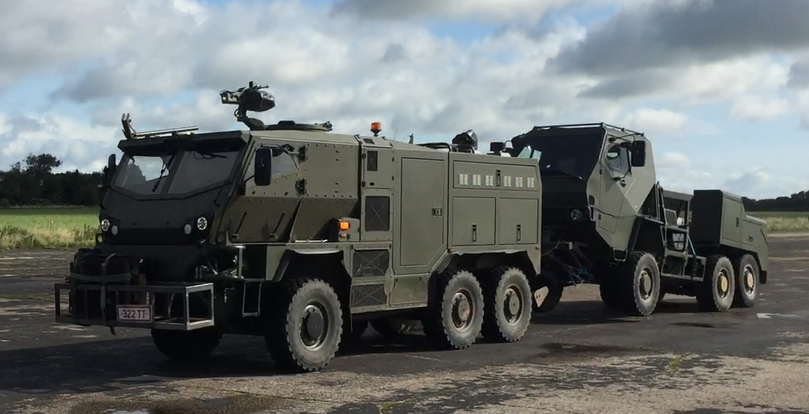

The General Dynamics Land Systems UK (GDLS) Ocelot
Another in-service UK designed vehicle, also much discussed in the UK military twitter-verse is the General Dynamics Land Systems (GDLS) Ocelot, known as the Foxhound Light Protected Patrol Vehicle in UK service. Designed by Force Protection and Ricardo in the UK to meet a UOR requirement to replace the Snatch Land-Rover and Vector, it utilises composite armour for lightweight protection, with a crew of 2 this vehicle carries four personnel or a “brick” on patrol. Designed to be modular, GDLS has built prototypes for cargo pick-ups and open cab M-WMIK-type variants. It has also marketed the concept of Ocelot-S – a steel armour version, which offers the same protection at an increased gross vehicle weight and reduced payload. With no CAD created line drawings, where necessary I have just used MS Paint to modify photos of existing models as a graphical depiction to back up the text.
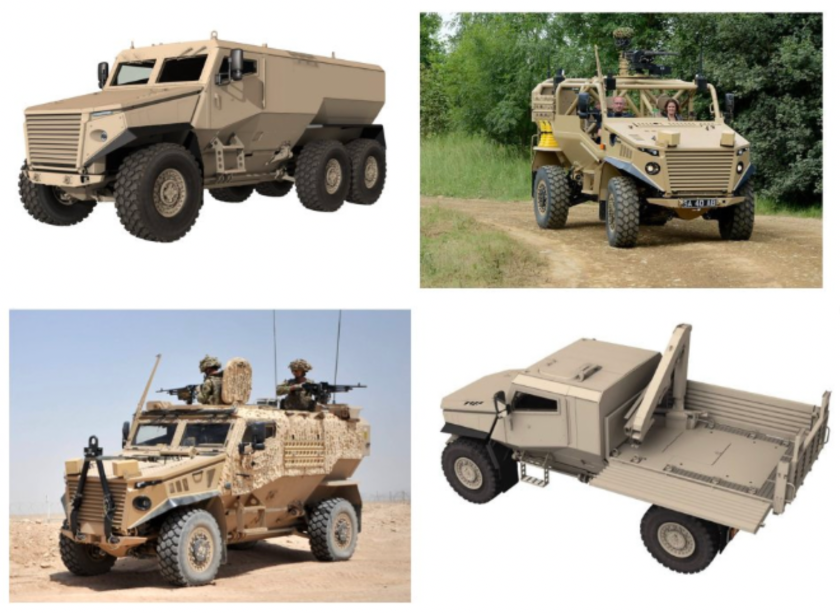
Ocelot / Foxhound versatility is based on the modular design. Different mission “pods” are fitted on the generic engine and chassis combination, based on an armoured “skate board” that carries the transmission and automotive components.

MRV-P Requirements
The protection requirement for MRV-P is Stanag 4569 Level 2 minimum, Level 3 aspirational, to protect crews from small arms fire and artillery shrapnel. Level 2 is 7.62 x 39mm AK rounds, and protection from 155mm artillery rounds exploding 80 meters away. IED / mine blast is Level 2A minimum, which is a 6kg HE mine under any wheel. Protected is the keyword here, this is not an armoured fighting vehicle.
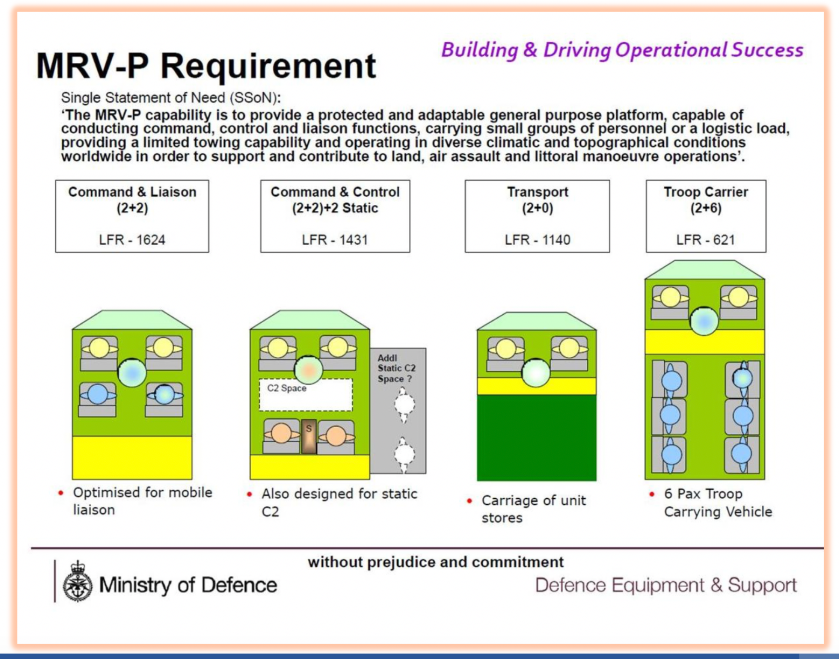
A replacement for the Panther CLV and Land-Rovers, this version is the Company/ Squadron Commander and RSM’s / CQMS’s wagon. With a driver and vehicle commander up front, and 2 pax in the back, the vehicle needs space for battle management system computers and Bowman radios.

Supacat CLV variant
The design of the Supacat HMT400 platform, puts the driver and vehicle commander in front of a mid-mounted engine, with two more seats further aft. In the Jackal M-WMIK the heavy weapons mount, is over the engine bay, the gunner standing on top of it when operating the .50 cal HMG or 40mm GMG. If the Command & Liaison vehicle does not need to have roof hatches in the same place (but perhaps rather, it would need them over the forward or aft seats) then the space over the engine bay provides ideal space for radios and computers, and maybe some equipment stowage. Note that on the Jackal Mk2 the spare wheel is on the inside of the armoured “door” and that on the opposite door is a storage compartment.

Taking the new LRV cab configuration, that would give us a layout that looks something like the vehicle depicted below:

Depending on the hatch configuration (the figure depicts 2; 1 over front seats and 1 over rear) this vehicle could have a pintle mounted MG with gun shield etc , or the lightweight RWS taken from the Panther CLV for self protection. Smoke grenade launchers, ECM antenna’s and a spare wheel are not depicted but could easily be fitted. The load deck could also carry the crew’s kit, water and fuel jerry-cans, ammunition, and camouflage nets etc.
The Jackal has a kerb weight of 5.5 Tonnes with armour package and fuel, and a payload of 2.1 Tonnes for a gross vehicle weight of 7.6 Tonnes. So with its full cab / superstructure, the MRV-P configuration might leave half to three quarters of a tonne mass capacity for use on the cargo deck.
Foxhound CLV variant
When it comes to Foxhound, it could be argued that a standard vehicle is already suitable for the CLV role, despite having 6 seats. Existing room in back is sufficient for the C4I fit, and, if 2 seats were removed, there would be no need for a new “pod” or mission module. While such a solution might not be optimal, it would utilise the existing design. These vehicles could be derivatives of the Ocelot-S version, with conventional steel armour, to ensure the vehicle remains affordable.
The artist’s impression below shows a 4-seat, 4-door pick-up variant of Foxhound that is equivalent to the JLTV.


Command & Control variant
This requirement is for an MRV-P variant with more command and control space, and less cargo space. Also potentially for more space in the static C2 role, a tent / pavilion is attached to provide more working space.

Supacat C2 variant
A Supacat HMT400 variant, with a full armoured cab module taking the whole length of the vehicle without the pickup truck style cargo deck could easily meet this requirement with the internal space available, in fact such a vehicle could potentially seat four in the back section, plus the two crew up front, with space for C2 electronics and some working space provided by fold down / fold out desks , map boards or large LCD displays etc.
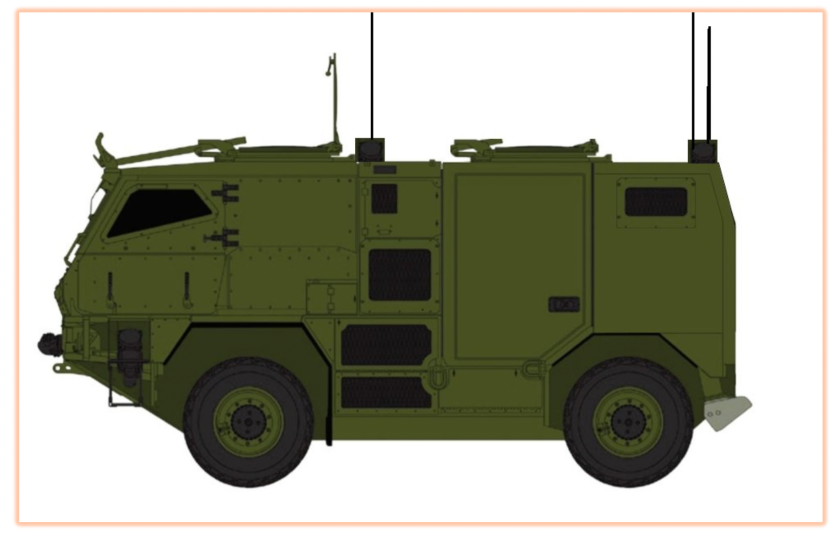
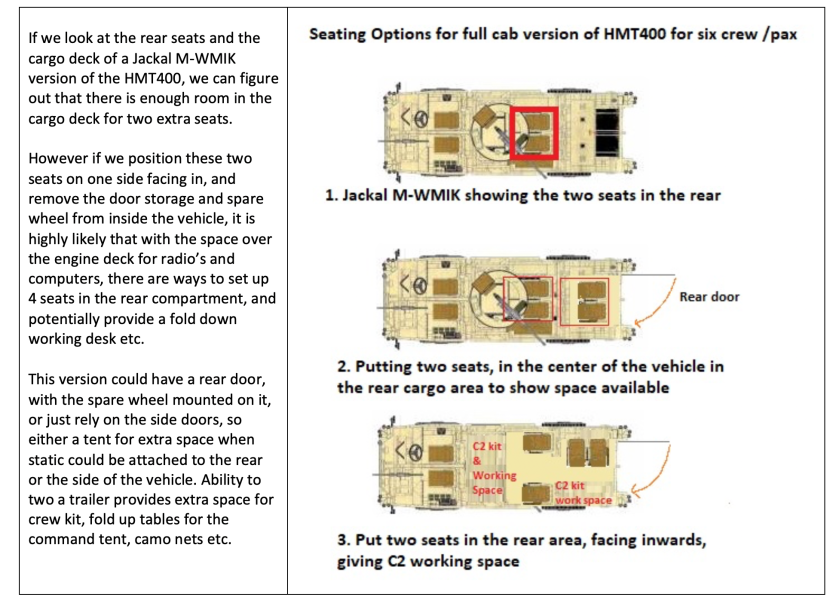

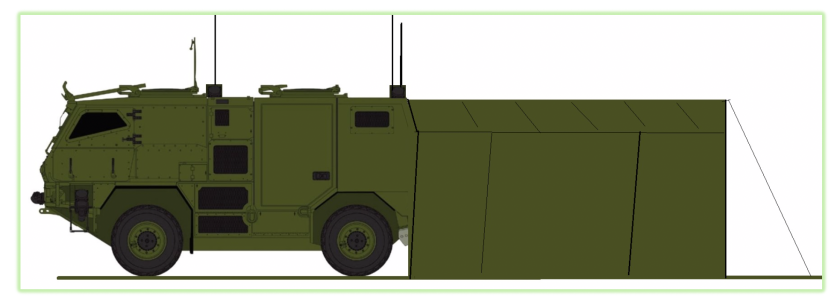
Foxhound C2 variant
This requirement would likely be met by using a standard Foxhound pod with a different seating / equipment layout in the back.
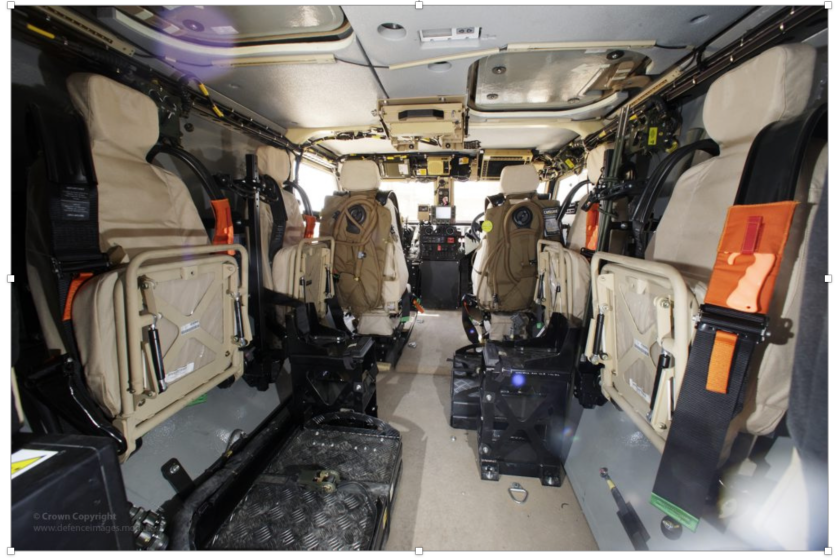
MRV-P Tactical Support Vehicle (TSV) variant
This variant of the MRV-P is a pick-up truck to carry unit stores, and can be seen as the direct replacement for the Husky TSV.

Supacat Transport / TSV variants
The Supacat HMT400 and HMT600 platforms provide a number of options for meeting this requirement, depending on the amount of stores that need to be carried, and crew total. The HMT400 full-cab version detailed above for the C2 requirement could carry cargo internally “under armour”. The “Crew cab” pick up variants could have two or four crew, and various cargo handling facilities could be mounted, including cranes for pallet handling or mini-DROPS / EPLS type platforms.
Size ranges go beyond the requirement depicted above to include the HMT600 6×6 versions, able to carry more cargo, and potentially replacing the Coyote TSV with a closed cab variant.



Foxhound Transport / TSV variants
GDLS has already developed a prototype that could meet this basic requirement, with 2 crew and a load-bed. Originally an extended wheel base 4 x 4 and 6 x 6 versions of the Foxhound were proposed, providing some flexibility in how the role was fulfilled, like the Supacat variants.
Interestingly, it is not clear whether the LPPV requirements included a tow hook. But adding one should not be an issue.
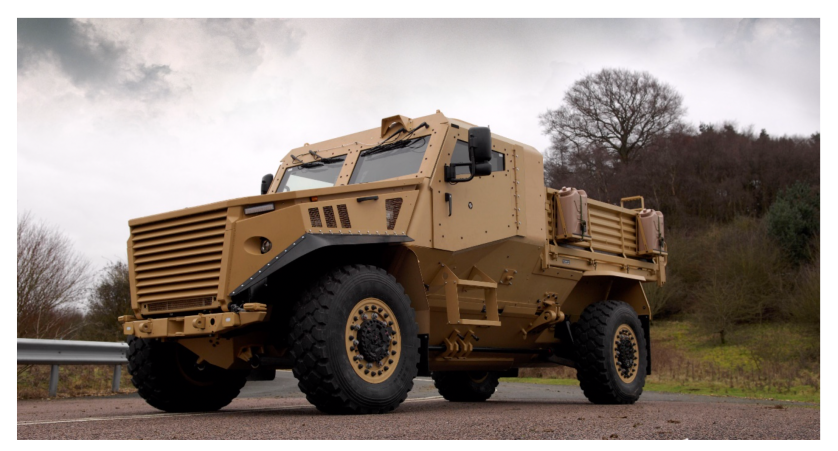
MRV-P Troop Carrier
The MRV-P troop carrier requirement is currently seen as being met by a bigger vehicle, the Thales Bushmaster seems to be a favourite, although there are other contenders. The bigger chassis also provides the basis of an ambulance variant.

Extrapolating the plan diagrams available on the web showing the seating plan of Jackal gets me to a slightly longer full cab version of the HMT400 than our friend Chris’ original drawing he published on Twitter, based on more overhang at the back of the vehicle. So that might give us something that looks like this, two rows of 3 seats in the back as per the block diagram in the requirements:

If two rows of three seats could not be fitted in the back while retaining the side doors, these could be deleted and a single large door at the back used as with other vehicles of this type.

A slightly longer body as show above on the HMT400 with more overhang at the rear, but without reducing the departure angle, might also allow for a litter to be carried, producing a simple casualty evacuation ambulance model.
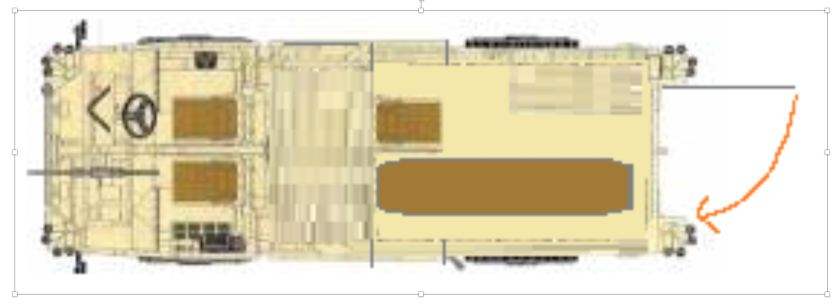
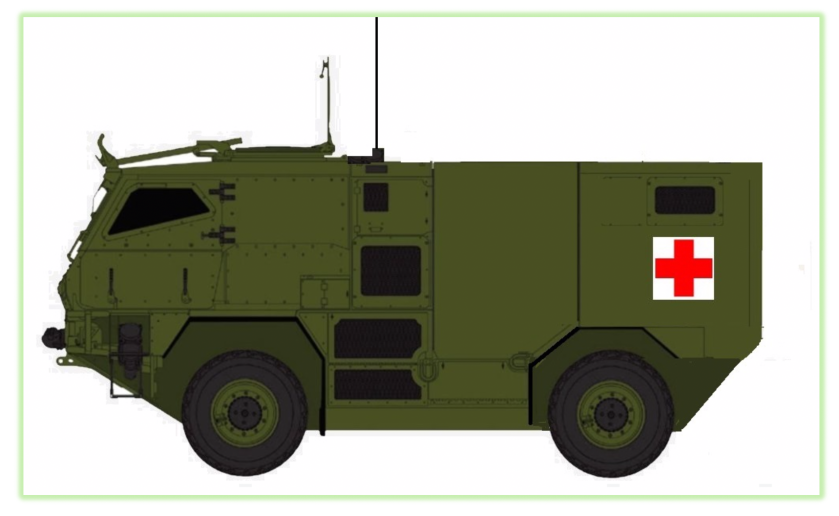
Supacat also has the longer HMT600 6×6 chassis as an option for an APC able to carry a full 8-man section in the back, or for an ambulance that can carry multiple casualties and / or provide more space for treatment on the move.
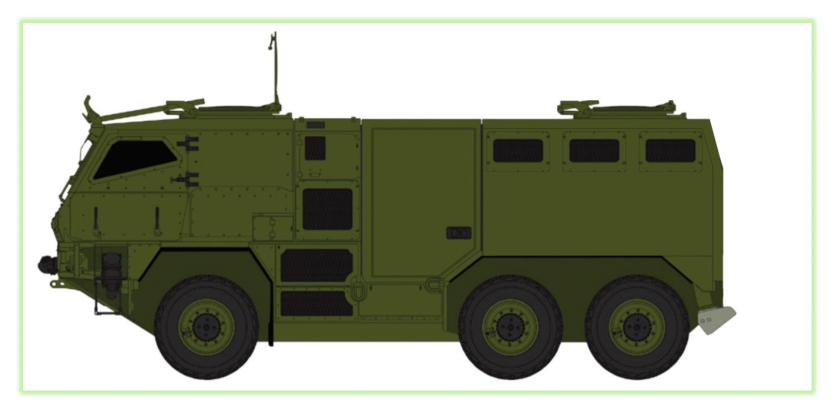
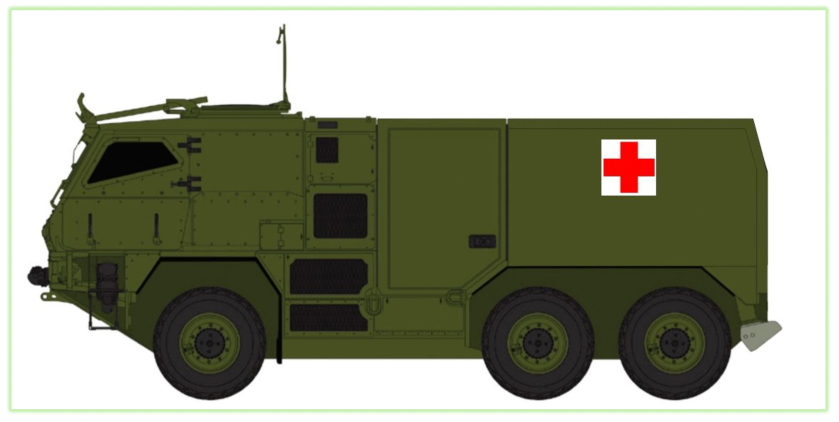
Foxhound Troop Carrier & Ambulance
A few years ago, when GDLS first floated the idea of an Ocelot-S version, with less-expensive steel armour, they produced images of a long wheelbase 4×4 as the troop carrier, and also a graphic of an ambulance version:


MRV-P Supacat Variants Summary
Between the HMT400 4×4 and HMT600 6×6 platforms, we have a common chassis, engine, drivetrain, and suspension, offering considerable commonality of spare parts across a range of vehicles that have interoperability with the existing Jackal M-WMIK and Coyote TSV fleets, that could potentially meet all of the MRV-P Phase 1 and 2 requirements.
Potentially, the closed cab variants could replace some if not all, of the Jackal and Coyote fleet. The HMT600 could also potentially replace Mastiff and Wolfhound, although with lower mine blast protection ratings. Supacat already built a prototype HIMARS type MLRS rocket launcher vehicle for the previous LIMAWS(M) requirement. The platform is big enough to carry Exactor precision guided missiles in support of light forces (the South Koreans and Israeli’s mount it on the Sandcat). Specialist versions for the Royal Corps of Signals; radio re-broadcast, EW etc seem a given, as the HMT600 was the platform for the Soothsayer system.
MRV-P GDLS Ocelot / Foxhound Variants summary
GDLS would have to fully develop the cheaper Ocelot-S steel armoured variants that they have suggested / marketed in the past. Foxhound, as it exists, is considered too expensive. However the basis is definitely there for a British-designed and produced vehicle to take-on a least some of the MRV-P roles alongside the existing fleet of 400 LPPVs. Again, the benefits of commonality are potentially substantial. With no 6×6 version in existence, it might be that Ocelot variants would be supplanted by an off the shelf purchase of something like the Thales Bushmaster at the larger end of the capability spectrum, such as the troop carrier and ambulance requirements.
Conclusion
In an army that drastically needs to be re-equipped with modern equipment, across support as well as combat vehicle fleets, the commonality provided by development of the Supacat HMT or GDLS Ocelot platforms could produce considerable benefits in through-life costs by standardising a single vehicle family across both MRV-P roles, and through commonality with existing in-service fleets. They provide an alternative “buy British” approach to the suggested FMS purchase of Oshkosh L-ATV (JLTV) for at least the MRV-P Package 1 requirements.

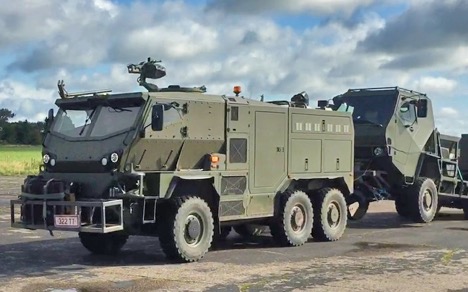
Hi Jed
A really fascinating piece on how British built alternatives to JLTV could save money while offering increased commonality. Some genuinely creative thinking going on here.
However, just two observations:
i) The first is a question. Concerns arose a while ago about Foxhound’s reliability in the heat of Afghanistan. Such concerns were about problems with engine cooling. Some alarmist reports came through, one soldier saying that he had had to alter the bonnets to try to increase the air supply to cool down the engines and another that the vehicles were left in the shade to cool between use!
Do you know anything more about such problems? Have they been resolved? It would be little use sending a Foxhound-based MRV(P) to a hot country if they have not!
ii) I was also interested in a piece of information you gave, which is not directly related to the central theme of your arguments. It concerns the fact that Supacat has recently designed a new armoured cab for the Lightweight Recovery vehicle. You add that it appears the Army is going to convert existing Coyote platforms to this new configuration to meet the requirement. Has it been confirmed yet that the Supacat vehicle will enter service? I know that it was being trialled by the Royal Marines a few months back. If it does enter service, it will be a good thing, as it will fill a gap that has been there since the demise of the old Bedford Light Recovery vehicle. A vehicle is certainly needed to manoeuvre and effect recovery in more confined spaces than the heavier MAN truck (excellent though it is) can manage.
LikeLike
A great piece many thanks I hadn’t realised the jltv cost had gone up so much! I guess like f35 the price could go lower later. However, due to the high cost and the fact we don’t seem to have a stake or any industrial benefit and we want the vehicles quite quickly, I think we should seriously consider these options. I wonder if the ocelot price may come down per unit if a large order such as the 1500 for jltv was made? I would like supacat if they haven’t already look to a central tire inflation system.
Which provides better protection ocelot or hmt? Can the s version of ocelot have an increase in power to balance the extra weight?
Do you think that there maybe any return to limaws/portee?
As an aside considering the weight of ajax is there any merit for 16th air assault to get a scimitar mk3 with either a bushmaster or CTA if possible. I know a400m can transport but can’t imagine useful for talo/air seizures? Also scimitar has a ch47 lift capability
LikeLike
Hi Mike W
I had seen the same reports about Foxhound, and no I have seen no official statement definitively outlining the problem nor any rectification for it. I would think if you wanted to go down an Ocelot family derivative for MRV-P you would take the opportunity to fix that defect.
I have also not seen any statement saying trials of the recovery vehicle variant have in fact been turned into solid orders at this time.
Simon – many good questions. I don’t think an increase in unit unumbers of the composite Foxhound LPPV cabin or module would provide the required decreases in cost. I think at the low protection levels required either design could be made to fit the bill with either step or composite armour packages.
LikeLike
Gents,
There is a ready solution to the overheating issue, a nanofluid called Hydromx is proven to improve heat transfer by 37%, so cooling the system with no requirement for larger radiators, vents etc.
View the product at; http://www.energyeffective.co.uk
LikeLike
I have always been uncomfortable with the JLTV purchase on cominality grounds. Whilst from a cost perspective is appears sensible to piggyback on the US contract. But with the price increase that doesn’t look that good. Despite being announced a long while ago we appear to be no further with actually getting a vehicle. A very interesting article one which makes a lot of sense. The development which cause a further delay one which may just be worth waiting for.
LikeLike
Excellent proposals. Sensible militarily, financially, industrially and politically.
LikeLike
There’s a commonality argument which we’re ignoring with the JLTV and that is the one between the US and UK, we’re not unknown for borrowing and the US will have a pile of spare parts bigger than the Great Pyramid at Giza, they’ll also pay to make sure JLTV works and develop plug and play attachments we can forgo buying until we need them as a UOR.
That being said I’d love to see a British solution to package one and my digging suggests that the overheating problems with Foxhound were simply due to their fitting an engine too small for the weight of the vehicle.
Package two and three, I’ve already mentioned over on TD that I’d like to see those folded into the MIV programme to make a go of ‘strike’, if you look at the proposed initial buy for boxer that would fulfil the core fighting requirements for nine infantry battalions, if you filled out the rest of the battalions and their supporting arms with MRV-P you’d have three full strength brigades. Though it’s a great vehicle I’m not convinced that Boxers will perform anything but the one task for most of their lives and there seems to be a tendency within the community to look at the all the modules being proposed as free fruit baskets. I suggested the Patria AMV XP 8×8 and the 6×6 patria (which is based on the same chassis but half the price). By combining MRV-P 2 and 3 with MIV and losing the Boxer gold plating you introduce a cohesive fleet to strike and could potentially look to include things like CTA40 and MMP, which I could argue would be of greater overall benefit to the concept.
If you remain unsold on Patria 6×6, it floats and if you added a flatbed it would kind of look like a Stalwart…
https://www.janes.com/article/85350/patria-6×6-testing-in-lapland
Great article, thank you for adding to the conversation, Nemo.
LikeLike
I was Patria’s UK advisor for four years. I always thought the AMV 8×8 was an excellent proposition for MIV. Not gold plated like Boxer or VBCI, but certainly good enough to fulfil all UK requirements. Patria’s new 6×6 is also a great vehicle and as you say, offers commonality with the AMV.
The Australian Land 400 Phase 2 competition was extremely well run. Based on our own analysis of other Boxer test data and Australia’s evaluation, We’ve now made the decision to go with Boxer. It is expensive, but it is a a superlative AFV with an extremely long service life ahead of it. I would like to see us acquire 1.800-2,000 not 500, so that it can completely replace FV432. I’d put nine mechanised battalions in a Boxer IFV; three cavalry regiments in a Boxer DFV / CRV; three artillery regiments in a Boxer 155mm RCH; three engineer regiments in a Boxer CEV; plus two further artillery regiments with ground launched Brimstone, and GBAD Boxer vehicles. Add HIMARS with GMLRS and a deep fires missile plus a counter-battery capability and you have the ingredients for a truly credible Strike Division with a “go anywhere, do anything capability.”
We have a total of 32 infantry battalions. Even with nine Mechanised Infantry battalions in Boxer, you still have a further 23 battalions that need some form of protected mobility. Assuming you put six battalions in a tracked IFV like Warrior, you still need an MRV-P Package 2 troop carrier. While I like both Foxhound and HMT, the Thales Bushmaster is excellent. I think it fulfils every requirement without compromise. This could equip an independent brigade that would be readily transportable by air to complement high readiness forces such as 16 AAB and 3 Commando Brigade. This plan would put 18 battalions in protected vehicles.
LikeLike
It’s the ‘good enough’ that interests me, Boxer may have the edge in protection, but at a cost, if that cost difference would put a turret on Patria then you might look at its armour package as being about four kilometres thicker than Boxers.
The argument over mixing wheels and tracks seems to have been forgotten for now but my suggestion would let Ajax help revive the armoured division and conjures up a mechanised division sooner rather than later and more or less within existing budgets, there’s no harm no foul that I can see unless it’s to argue weight.
But as you say, the decision has been made.
LikeLike
Hi Jed,
Great article!
I’ve become fascinated by this topic over the years.
I wonder if you’ve seen this before – an overview of the Lockheed Martin AVA prototype.
https://www.theengineer.co.uk/prototype-military-vehicle-aims-to-cut-casualties/
The narrative used in the article is frustrating similar to the MRV-P requirement and it would appear SUPACAT have already provided the baseline vehicle in 4×4 and 6×6 configurations. What went wrong I wonder???
James
LikeLike
A further search, I found images striking similar to the article. Looks like this could have been sorted 9 years ago.
LikeLike
Jed,
Supacat are clearly taking note as they’ve updated their website with this…
https://www.google.com/search?q=supacat+hmt+lwr&rlz=1CDGOYI_enGB806GB807&hl=en-GB&prmd=isnv&source=lnms&tbm=isch&sa=X&ved=2ahUKEwiolIu77N7gAhWIoBQKHba0Dt0Q_AUoAXoECAwQAQ&biw=375&bih=551#imgrc=6EOTc3k5DokNgM
I wonder if we could convince Defence to replace the Land Rover fleet with variants of the Supacat Lightweight Reconnaissance Vehicle?
https://supacat.com/products/lrv/
Group all this together with the MRV-P requirement, maximise economies of scale, promote the UK prosperity agenda etc etc.
Too far maybe!
James
LikeLike
The MOD brought Cougar from Force Protection on a UOR and shelved the OUVS requirement the Lockheed Martin AVA was designed to meet.
LikeLike
JamesH and AndrewB
Oh yeah I am pretty sure we could indeed have fulfilled this requirement, had we articulated fully , a decade ago. Although possibly at the time, we were more interested in replacing FV432 and maybe even Saxon? However, yes, our procurement processes do seem get in the way of themselves don’t they ! I believe AXA prototype was shown in relation to MRV-P’s predecessor, the Operational Utility Vehicle System (OUVS).
LikeLike
As with new RN vessels, we should always attempt to build in the UK. Let’s face it, the Jackals and Supacats are excellent vehicles and a good example of buying domestic products. The MOD should only consider foreign products as a last resort.
LikeLike
I’m a bit late to the debate but I don’t think the HMT 400/600 is the vehicle we should choose as the basis for the MRVP requirement. The mid mounted engine seems to preclude it in terms of ease of operation for the various roles required. At the moment it’s not too much of a problem as it is used in an open configuration so access to the engine is not prohibited as much as would be the case once we start to add enclosed structures covering the entire length of the chassis.
The RG35 has a similar layout but with the powerpack mounted on rails so that it can be slid out and changed in a similar manner to modern AFV’s (I may be wrong and the Jackal has a similar system but I have seen no evidence of this) and the Foxhound has an excellent system to allow access for maintenance coupled with the ability to perform an engine change in a short period of time due to it being placed cab forward, which is also a benefit it has in protection over the HMT which has members of the crew riding over the forward axles.
Personaly I would take a look at the PMPV 6×6 MISU as the basis for our MRVP requirement.
https://www.armyrecognition.com/finland_finnish_army_wheeled_armoured_vehicle_uk/pmpv_6x6_misu_mrap_vehicle_personnel_carrier_technical_data_sheet_pictures_video_12611154.html
This vehicle could be configured for a multitude of roles without much problem (it’s basically a truck) and as being amphibious would allow our light mech units gain a capability we lost decades ago.
Which brings me to the question of what our light mech units are actually for? To my mind they are our expeditionary forces capable of deploying at distance with a smaller logistical footprint than the Strike Bde’s or to terrain not suited to the larger vehicles of both our Strike or armoured units and allow 16AAB and 3 Cdo Bde to be supported by a true mech capability, so they require the MRVP to be the basis of a family of vehicles such as troop carrier, logistics carrier and artillery tractor etc in the same vein as the Boxer for the Strike Bde’s.
A mix of PMPV and Vikings would be ideal vehicles to base our light mech units on.
Whichever vehicle we choose I hope we insist on building them here especially as there is a large pool of skilled auto labour and a factory going spare with the associated infrastructure in Swindon in a few years time.
Oh and buy enough to equip some reserve units as well and that goes for MIV too.
LikeLike
Enough holes in this to drive a Foxhound through sideways, but then again the only people that would know that, are the people with knowledge of Foxhound. As for comments re the overheating, wrong, wrong and ,, incredibly wrong!
LikeLike
Interesting recent updates on Supacat’s website. The HMT has a range of fully enclosed variants including an ambulance. Interestingly they have new chassis and variants of the smaller LRV.
HMT https://supacat.com/products/hmt/
LRV https://supacat.com/wp-content/uploads/sites/3/2019/08/LRV-Platform-Datasheet.pdf
LikeLike
The “problem” is that is just a graphic on the Supacat site, the only closed cab variant produced as a prototype and seen by the Army and the public is the MRVP-Phase 3 Recovery Vehicle demonstrator.
LikeLike
Does anyone know how much further MRV P has got in the last year since this post was made
LikeLike
MRVP 1 – looks set to be JLTV with Oshkosh stating they have met cost of 250k per vehicle
MRVP 2 seems to be stalled but currently between Bushmaster MR6 or Eagle 6×6.
I can’t see UK upsetting USA so JLTV pretty much a stick on.
UK work share seems limited for MRVP 2 & I don’t believe the cost is as significantly lower to justify the 2 candidates vs British solution. So there is a possibility this could change.
LikeLike